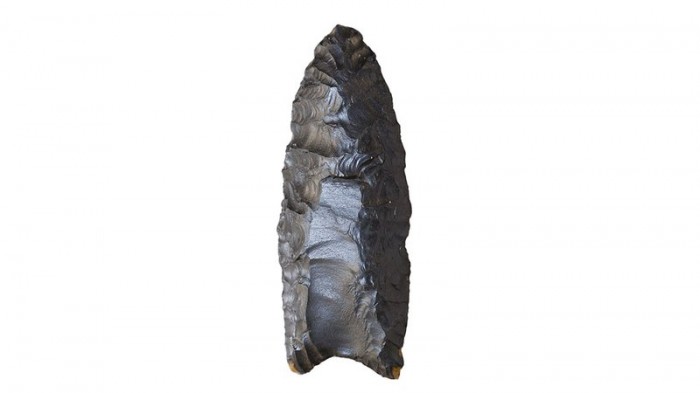What I did on my summer vacation: Fifth grader unearths ancient artifact at the beach

Ten-year-old Noah Cordle visited the National Museum of Natural History on November 3 to donate a Clovis point he found in New Jersey. He and his parents (right) met with the museum’s Dennis Stanford (left). (Photo by Donald E. Hurlbert)
Noah Cordle and his family were vacationing on Long Beach Island in New Jersey last summer when a discovery cut his boogie boarding session short. Something pointy brushed against his leg. “It didn’t feel like any of the other shells,” he says. He reached into the water and pulled out an object. Without his glasses on, he thought it looked like an arrowhead or a giant shark tooth. It was about the length of his palm and the color of charcoal. His family contacted the New Jersey State Museum and learned that it was likely a hunting tool used by early Americans thousands of years ago. Any doubts they had turned to excitement. “I thought it was a waste of time,” Brian Cordle, Noah’s father, says was his initial reaction. “I was a nonbeliever, but they converted me.”
Noah, who is 10 years old and lives in Fairfax, Virginia, visited the National Museum of Natural History November 3 to meet with archaeologists and donate his finding, which experts say is a Clovis point. The museum has several hundred in its collection – one of which was discovered as far back as the 1870s – but Noah’s is the first one to join the collection from New Jersey. “You can lay out Clovis points from one end to the other, from California and now New Jersey, and look at them and study them side by side,” says Pegi Jodry, a curator in the museum’s archaeology department. She says the museum will make a cast of Noah’s point for him.
Hurricane Sandy devastated Long Beach Island in October 2012, and it’s possible that efforts to restore sand to the beaches made Noah’s discovery possible. The point may have been buried for thousands of years until those replenishment efforts moved sand around, a New Jersey archaeology expert told Asbury Park Press.

Pegi Jodry (left) and Dennis Stanford (second from left), archaeology experts at the Natural History Museum, explained to Noah and his family how the tool was once used. (Photo by Donald E. Hurlbert)
At the Natural History Museum yesterday, Dennis Stanford, the Smithsonian’s expert in Paleoindian archaeology and stone tool technology, showed Noah how ancient hunters would have attached the point to a spear and thrown it at creatures like mastodon. “It’s been used and re-sharpened several times,” Stanford told Noah about his artifact. Noah’s response: “Whoa.”
Experts consider the Clovis to be among the first Americans. Stanford says the artifact is “a classic Clovis point”, dating from 13,500 to 14,000 years ago and made of a silicate, probably jasper. The museum will conduct a morphometric analysis to study its shape and how it was made. Stanford says it’s black because it had been in salt water for so long, left behind when sea levels rose after the Ice Age.

Smithsonian experts say the point is likely 13,500 to 14,000 years old. (Photo by Donald E. Hurlbert)
Noah is in the fifth grade and says his favorite school subject is science. He’s a fan of ancient artifacts. Before his grandfather passed away earlier this year, the two of them would walk around in search of arrowheads, which are typically around 5,000 years old. Noah says he’s unsure of what he wants to be when he grows up, but Stanford hints that he should consider a career in archaeology. After all, Stanford discovered his first arrowhead when he was nine years old, he says, “and look what happened to me.”
Stanford says that Clovis points are rare, but it’s not uncommon to find them on beaches. However, usually someone goes looking for them, not the other way around. “That’s never happened to anybody that I know of,” he says about the point washing up to Noah. “You gotta be in the right place at the right time or it will disappear just like that. He was really lucky.”

Noah Cordle, a fifth grader who lives in Virginia, found the Clovis point while boogie boarding last summer in New Jersey. (Photo by Donald E. Hurlbert)
This article by Max Kutner, an editorial intern with Smithsonian, was originally published on Smithsonian.com.
Posted: 7 November 2014



